Designed for data centers: a new generation of Dell EMC PowerEdge servers and converged systems
Modern data center server platforms are becoming more economical, energy efficient, and scalable to meet new requirements. Thanks to the latest generation of processors, they have become more attractive both for traditional use and for virtual and cloud environments.

Server solutions satisfy the market demand for highly scalable energy-saving systems for different types of loads. Among the trends we can highlight the increase in the number of cores, increase in the performance and energy efficiency of processors, as well as improved support for virtualization.
More and more companies are using x86 architecture servers to solve business-critical tasks. Approaches to building data centers are constantly changing, and this entails the need for a wide range of server solutions.
')
In the past year, Dell EMC released the 14th generation of Dell EMC PowerEdge servers . They were announced at the Dell EMC World 2017 conference in Las Vegas and presented at the Dell EMC Forum 2017 autumn forum in Moscow. New items are based on Intel Xeon Scalable processors, optimized for NVMe and designed to:

These systems are optimized for a variety of loads, equipped with automated controls and built-in security features.
The 14th generation of the Dell EMC PowerEdge servers is another increase in computing power, high capacity, low power consumption, high memory density for modular solutions, scalable storage system with a wide choice of disks and drives, including All-flash and NVMe in all forms -factors.

New generation servers have increased energy efficiency: thanks to Dell Fresh Air technology, equipment can be operated at temperatures up to 40 ° C, and this significantly reduces electricity consumption.
High-density flash memory configurations allow you to move data as close as possible to the processors, improving server performance, especially for transactional workloads. The ability to combine capacious disks and SSD-drives in one server platform, as well as support for caching significantly reduce data access time. NVMe super-performance SSDs with direct connection to a PCIe bus speed up application performance. Expanded and support for graphics accelerators:
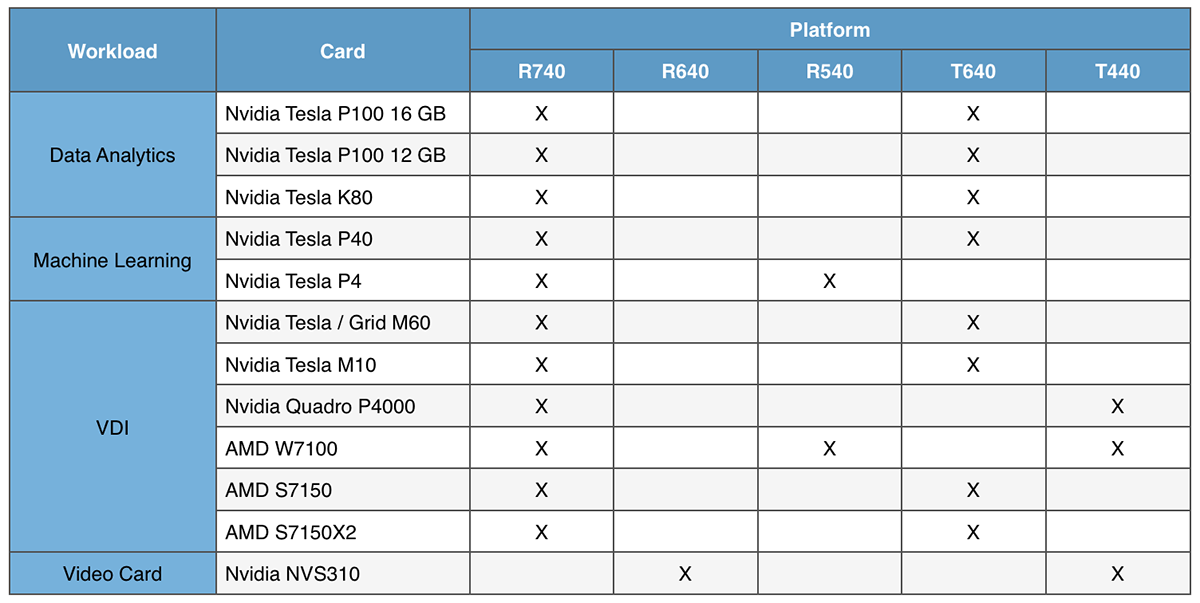
Also, the changes affected the RAM. First, this increased throughput due to the transition from four channels to six, and secondly, the new RAM modules provide an increase in speed from 2400 to 2667 MT / s.
Simple and powerful administration tools (Dell OpenManage toolkit) allow you to quickly deploy new services and manage equipment from anywhere.
The new OpenManage Enterprise Management Console with the RESTful API offers tools to automate the deployment, updates, monitoring and server maintenance.


OpenManage is an easy-to-use and install Dell EMC fleet monitoring and management system. Its main functions are:

With agentless administration, Dell EMC OpenManage helps you run PowerEdge servers by intelligently and automatically managing day-to-day tasks. In addition, OpenManage Enterprise offers customizable reports and automatic hardware detection features. Through QuickSync 2, you can access servers from a phone or tablet.
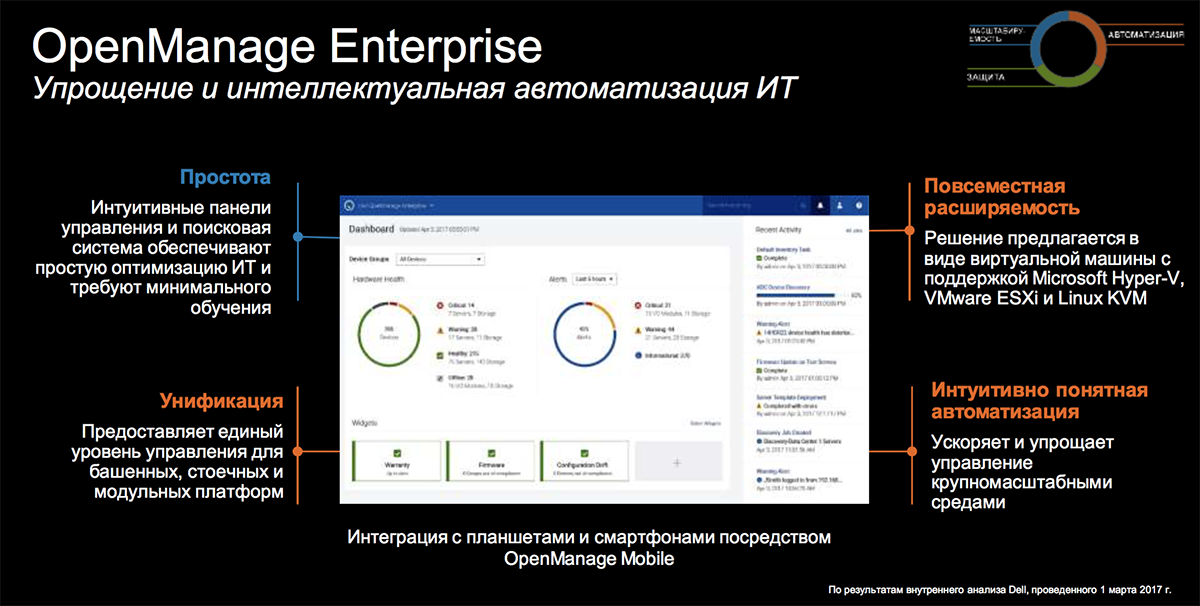

At the core of each PowerEdge server is a cyber-resistant architecture designed to provide security throughout its life cycle. It includes cryptographically secure booting of Intel Boot Guard, signed firmware, automatic BIOS recovery, and System Lockdown, a feature that protects your system configuration from malicious or unintended changes. Cryptographically signed firmware packages and secure download guarantee data protection.
System Erase tools allow you to erase data from drives and other built-in long-term memory when decommissioning servers or reorienting to other tasks. System Erase provides fast and secure deletion of all data from storage media, including hard drives, SSD and system memory.
At the time of this writing, the new generation PowerEdge servers were available in rack and blade server families. Now tower models are also available, but not included in this review.
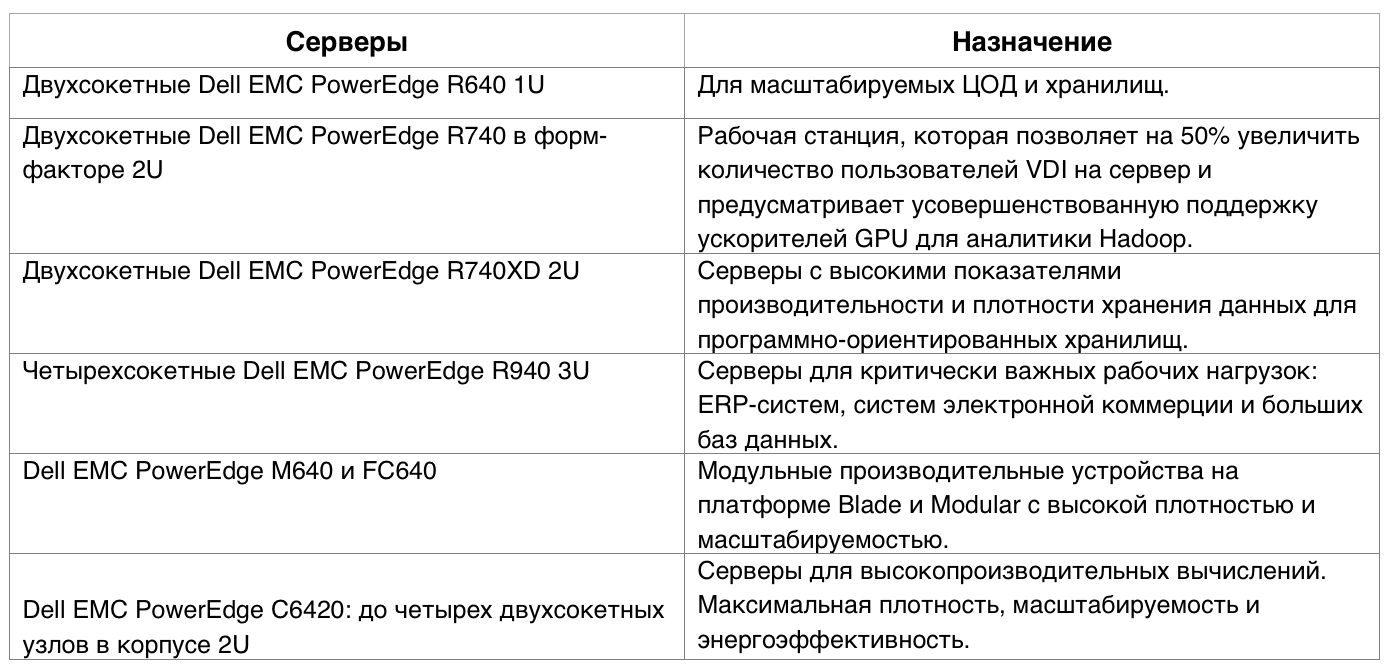

The expansion of NVMe's portfolio in new systems is not accidental. According to forecasts, by 2020 more than 50% of servers will be supplied with NVMe drives, an average of 5.5 NVMe drives per server.
This protocol for access to non-volatile memory was created for high-speed connection of a flash drive via the PCI Express bus. Due to the increased number of queues and commands in NVMe, a high degree of parallelism is provided, and as a result, the efficiency of work with modern multi-core processors is increased. Due to the "lightness" of the protocol, delays are reduced when working with flash memory, and the drivers take up less space.
NVMe provides better results than existing disk protocols and is increasingly being used as a PCIe server flash protocol. Thanks to M.2 SSD with NVMe support, hyperconvergent systems can become much more powerful, get impressive capacity and much higher throughput.
14G servers support 2–3 times the size of NVMe 2.5 ”PCIe solid-state drives. In total, this gives up to 6.4 TB using 2.5-inch devices. NVMe PCIe SSD support is provided for rack-mount models R640, R740, R740xd and R940, floor T640 and convergent FX2 systems with FC640 modules.
It uses a broad portfolio of drives, including:
PowerEdge servers will become part of data centers and storage, hyperconvergent devices and racks, hybrid cloud platforms, ready-made nodes and other Dell EMC solutions. By developing hardware and software, the manufacturer can test them together and achieve a high level of system optimization.

The new servers are the foundation for upgrading Dell EMC solutions that used the previous generation of PowerEdge: VxRail, VxRack, XC Series, VSAN Ready Nodes, ScaleIO Ready Nodes, IsilonSD Edge and Elastic Cloud Storage. In addition, servers are available in many new Dell EMC solutions and platforms, including the Data Domain Appliance, CloudArray, Ready Bundles, Ready Systems, Dell EMC Enterprise Hybrid Cloud, Dell EMC Native Hybrid Cloud, and Dell EMC Cloud for Microsoft Azure Stack. Consider new items in more detail.
The Dell EMC PowerEdge R640 Rack Server is a platform for horizontally scalable data centers with high computing density and data storage on a 2U dual-socket platform.

The Dell EMC PowerEdge R740 Rack Server is a system for demanding environments with balanced storage, I / O, and CPU performance for application acceleration. The 2U / 2S platform has configuration flexibility, allowing you to increase the number of users of virtual desktops per server by up to 50%. In addition, the solution provides support for the GPU accelerator for Hadoop analytics.
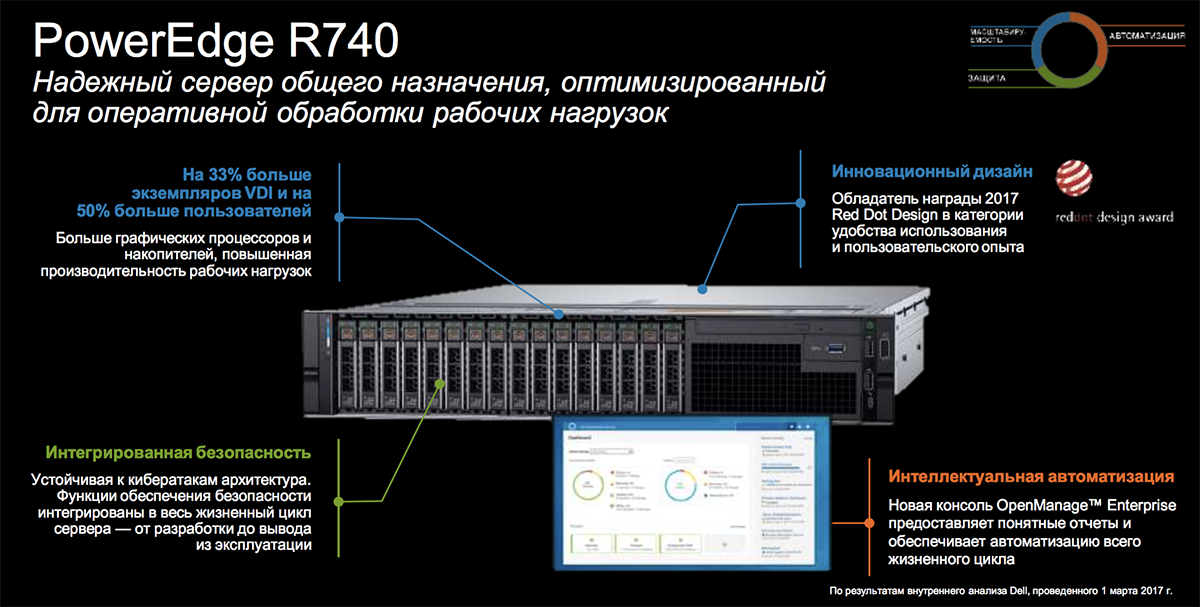
The Dell EMC PowerEdge R740XD Rack Server is a 2U / 2S platform with high performance and storage density for software-based storage. It is universal, which is especially important for cloud service providers and hosting providers with colocation services. The server can also be used for Hadoop tasks and big data analytics.

It is interesting to compare two options for configuring these servers with NVMe drives:

The Dell EMC PowerEdge R940 Rack Server supports mission-critical workloads and helps save up to $ 600,000 on Oracle licensing costs. Up to 44% speeds up the work of the SAP SD Sybase Environment.
As an example, we give its technical characteristics:
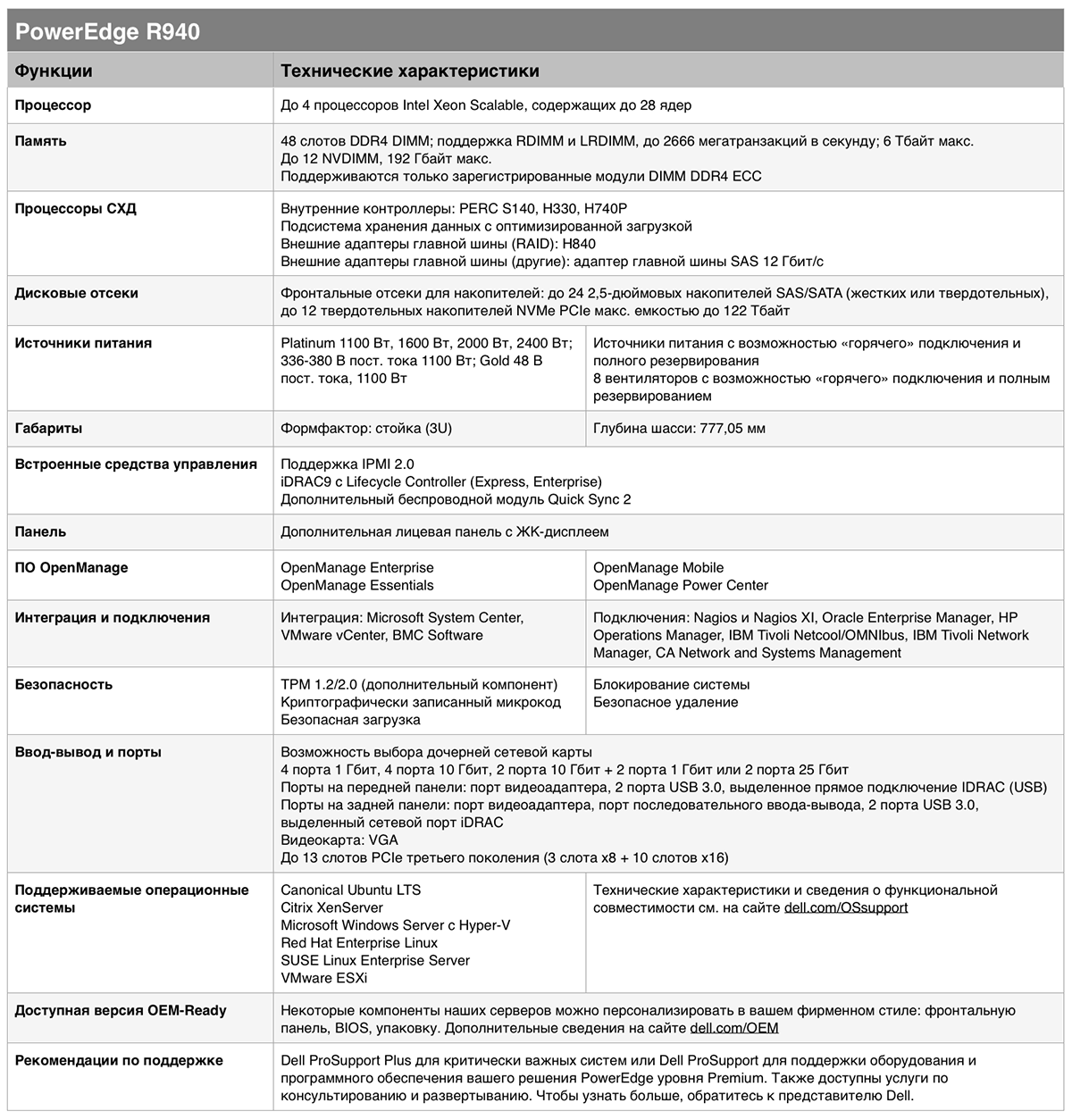

Dell EMC PowerEdge M640 - Modular servers with high performance, density and scalability.

Key features of the Dell FC640 server:
Providing computing and network resources, as well as data storage, PowerEdge modules allow you to select the optimal configuration, quickly deploy and administer the infrastructure.
And finally, PowerEdge C6420 . It focuses on high performance computing and horizontally scalable loads. The universal platform of a form factor 2U is mounted in a rack and can contain up to 4 dual-processor servers.

Dell EMC Converged and Hyper-Converged Solutions
The hyper-convergent solutions model is aimed at maximizing the time it takes to commission a system. The stages of its configuration, launch and update throughout the entire life cycle are accelerated. Delivered systems are almost ready to work. They allow you to flexibly expand or reduce infrastructure, or to start with a small “building block” (such as VxRail), gradually increasing the solution.
The integrated system is factory tested and controlled from a single interface. It is also served as a single device. The end user may not think about what is inside - he just solves his problems.
The system configuration depends on the type of nodes used. There are solutions where some nodes are responsible for computing, others for storing data. With a small number of nodes, the access switches already in the system are sufficient.
The possibilities of building convergent and hyperconvergent systems are largely determined by software.

VxBlock systems provide comprehensive integration of Dell EMC, VMware, and Cisco enterprise-class resources, networks, storage systems, and enterprise-class virtualization technologies. VxBlock allows you to manage computing and network resources, storage and virtualization as a whole. Systems with a converged infrastructure are manufactured, managed, maintained and maintained as complex products and allow mixed workloads.
VxRail is a family of devices with support for fully integrated, configured, and tested VMware hyperconvergence infrastructures. They simplify IT operations, reduce capital and transaction costs. Combined with Dell PowerEdge servers, VxRail provides customizable devices for any use case.

Convergent and hyperconvergent solutions eliminate the isolation of systems, combining servers, storage systems and network resources into one. Both are promising for data centers. However, converged systems differ from hyperconvergent systems in that they rely on storage area networks (SAN). When using, for example, VxBlock, the storage capacity can be increased without changing computing resources.
If for some reason high availability, guaranteed latency and maximum SAN performance are important for the application, it’s best to use a converged solution.
In the case of hyperconvergent systems, data storage is virtualized, with two approaches possible: VSAN and ScaleIO. ScaleIO has no physical limitations on the number of servers and addressable storage capacity — you can add as many resources as you need. Therefore, when mass horizontal scaling is required, it makes sense to use ScaleIO as the underlying virtualization technology. If you plan to start small and then increase resources, then VSAN would be the best choice.
The VSAN and ScaleIO environments are worth considering when an application can run in them. In this case, it is worth planning to use hyperconvergence in the data center - the next generation technology. Moreover, the virtualized storage environment is very fast approaching in its capabilities and characteristics to the SAN. At the same time, hyperconvergence works best when paired with software-configured networks (SDN). During the transition to hyperconvergence, storage configuration is performed at the hypervisor level.
If you do not need to virtualize the network and preferably maintain the existing one, then you can use solutions such as VxRail, where there is no separate network subsystem. Those who are ready for network virtualization need to decide which stack to use — VMware, Cisco, or open source. For example, VMware has rack-scale solutions - VxRack STDC with integrated support for NSX. This is a hyper-convergent system with network virtualization. VxRack Flex is neutral to the hypervisor and can integrate with other SDN technologies.
So far, convergent solutions are sold many times more than hyperconvergent solutions, but according to forecasts, in the next one or two years, the latter will become the leaders in terms of sales.

Server solutions satisfy the market demand for highly scalable energy-saving systems for different types of loads. Among the trends we can highlight the increase in the number of cores, increase in the performance and energy efficiency of processors, as well as improved support for virtualization.
More and more companies are using x86 architecture servers to solve business-critical tasks. Approaches to building data centers are constantly changing, and this entails the need for a wide range of server solutions.
')
14th generation PowerEdge
In the past year, Dell EMC released the 14th generation of Dell EMC PowerEdge servers . They were announced at the Dell EMC World 2017 conference in Las Vegas and presented at the Dell EMC Forum 2017 autumn forum in Moscow. New items are based on Intel Xeon Scalable processors, optimized for NVMe and designed to:
- traditional and cloud applications
- software defined data warehouses
- convergent and hyper-convergent infrastructures.

These systems are optimized for a variety of loads, equipped with automated controls and built-in security features.
The 14th generation of the Dell EMC PowerEdge servers is another increase in computing power, high capacity, low power consumption, high memory density for modular solutions, scalable storage system with a wide choice of disks and drives, including All-flash and NVMe in all forms -factors.

New generation servers have increased energy efficiency: thanks to Dell Fresh Air technology, equipment can be operated at temperatures up to 40 ° C, and this significantly reduces electricity consumption.
High-density flash memory configurations allow you to move data as close as possible to the processors, improving server performance, especially for transactional workloads. The ability to combine capacious disks and SSD-drives in one server platform, as well as support for caching significantly reduce data access time. NVMe super-performance SSDs with direct connection to a PCIe bus speed up application performance. Expanded and support for graphics accelerators:

Also, the changes affected the RAM. First, this increased throughput due to the transition from four channels to six, and secondly, the new RAM modules provide an increase in speed from 2400 to 2667 MT / s.
Simple and powerful administration tools (Dell OpenManage toolkit) allow you to quickly deploy new services and manage equipment from anywhere.
Intelligent Automation
The new OpenManage Enterprise Management Console with the RESTful API offers tools to automate the deployment, updates, monitoring and server maintenance.


OpenManage is an easy-to-use and install Dell EMC fleet monitoring and management system. Its main functions are:
- server monitoring, storage, network equipment Dell EMC;
- automate the opening of incidents using Support Assist;
- lifecycle management, configuration management, OS installation, etc.

With agentless administration, Dell EMC OpenManage helps you run PowerEdge servers by intelligently and automatically managing day-to-day tasks. In addition, OpenManage Enterprise offers customizable reports and automatic hardware detection features. Through QuickSync 2, you can access servers from a phone or tablet.


Integrated security
At the core of each PowerEdge server is a cyber-resistant architecture designed to provide security throughout its life cycle. It includes cryptographically secure booting of Intel Boot Guard, signed firmware, automatic BIOS recovery, and System Lockdown, a feature that protects your system configuration from malicious or unintended changes. Cryptographically signed firmware packages and secure download guarantee data protection.
System Erase tools allow you to erase data from drives and other built-in long-term memory when decommissioning servers or reorienting to other tasks. System Erase provides fast and secure deletion of all data from storage media, including hard drives, SSD and system memory.
For any tasks
At the time of this writing, the new generation PowerEdge servers were available in rack and blade server families. Now tower models are also available, but not included in this review.


The expansion of NVMe's portfolio in new systems is not accidental. According to forecasts, by 2020 more than 50% of servers will be supplied with NVMe drives, an average of 5.5 NVMe drives per server.
This protocol for access to non-volatile memory was created for high-speed connection of a flash drive via the PCI Express bus. Due to the increased number of queues and commands in NVMe, a high degree of parallelism is provided, and as a result, the efficiency of work with modern multi-core processors is increased. Due to the "lightness" of the protocol, delays are reduced when working with flash memory, and the drivers take up less space.
NVMe provides better results than existing disk protocols and is increasingly being used as a PCIe server flash protocol. Thanks to M.2 SSD with NVMe support, hyperconvergent systems can become much more powerful, get impressive capacity and much higher throughput.
14G servers support 2–3 times the size of NVMe 2.5 ”PCIe solid-state drives. In total, this gives up to 6.4 TB using 2.5-inch devices. NVMe PCIe SSD support is provided for rack-mount models R640, R740, R740xd and R940, floor T640 and convergent FX2 systems with FC640 modules.
It uses a broad portfolio of drives, including:
- devices of the new type Read Intensive,
- products of two brands, Samsung and Intel,
- solutions with full integration with controls.
PowerEdge servers will become part of data centers and storage, hyperconvergent devices and racks, hybrid cloud platforms, ready-made nodes and other Dell EMC solutions. By developing hardware and software, the manufacturer can test them together and achieve a high level of system optimization.

The new servers are the foundation for upgrading Dell EMC solutions that used the previous generation of PowerEdge: VxRail, VxRack, XC Series, VSAN Ready Nodes, ScaleIO Ready Nodes, IsilonSD Edge and Elastic Cloud Storage. In addition, servers are available in many new Dell EMC solutions and platforms, including the Data Domain Appliance, CloudArray, Ready Bundles, Ready Systems, Dell EMC Enterprise Hybrid Cloud, Dell EMC Native Hybrid Cloud, and Dell EMC Cloud for Microsoft Azure Stack. Consider new items in more detail.
New models
The Dell EMC PowerEdge R640 Rack Server is a platform for horizontally scalable data centers with high computing density and data storage on a 2U dual-socket platform.

The Dell EMC PowerEdge R740 Rack Server is a system for demanding environments with balanced storage, I / O, and CPU performance for application acceleration. The 2U / 2S platform has configuration flexibility, allowing you to increase the number of users of virtual desktops per server by up to 50%. In addition, the solution provides support for the GPU accelerator for Hadoop analytics.

The Dell EMC PowerEdge R740XD Rack Server is a 2U / 2S platform with high performance and storage density for software-based storage. It is universal, which is especially important for cloud service providers and hosting providers with colocation services. The server can also be used for Hadoop tasks and big data analytics.

It is interesting to compare two options for configuring these servers with NVMe drives:

The Dell EMC PowerEdge R940 Rack Server supports mission-critical workloads and helps save up to $ 600,000 on Oracle licensing costs. Up to 44% speeds up the work of the SAP SD Sybase Environment.
As an example, we give its technical characteristics:


Dell EMC PowerEdge M640 - Modular servers with high performance, density and scalability.

Key features of the Dell FC640 server:
- High database performance. Accelerated response time provides a 12-fold increase in the number of operations per second.
- Rapid migration of virtual machines. With the help of 25GbE controllers with RDMA support, the CPU load can be reduced by 75%.
- Increased array performance. Thanks to a 6-fold increase in the number of NVMe drives, a 5-fold increase in the capacity of flash memory and the support of a larger number of I / O slots, we achieved high rates of resource allocation.
- Data is protected by an integrated set of security features. Among them - blocking changes to server microcode and automatic deletion of information during server decommissioning.
Providing computing and network resources, as well as data storage, PowerEdge modules allow you to select the optimal configuration, quickly deploy and administer the infrastructure.
And finally, PowerEdge C6420 . It focuses on high performance computing and horizontally scalable loads. The universal platform of a form factor 2U is mounted in a rack and can contain up to 4 dual-processor servers.

Dell EMC Converged and Hyper-Converged Solutions
The hyper-convergent solutions model is aimed at maximizing the time it takes to commission a system. The stages of its configuration, launch and update throughout the entire life cycle are accelerated. Delivered systems are almost ready to work. They allow you to flexibly expand or reduce infrastructure, or to start with a small “building block” (such as VxRail), gradually increasing the solution.
The integrated system is factory tested and controlled from a single interface. It is also served as a single device. The end user may not think about what is inside - he just solves his problems.
The system configuration depends on the type of nodes used. There are solutions where some nodes are responsible for computing, others for storing data. With a small number of nodes, the access switches already in the system are sufficient.
The possibilities of building convergent and hyperconvergent systems are largely determined by software.

VxBlock systems provide comprehensive integration of Dell EMC, VMware, and Cisco enterprise-class resources, networks, storage systems, and enterprise-class virtualization technologies. VxBlock allows you to manage computing and network resources, storage and virtualization as a whole. Systems with a converged infrastructure are manufactured, managed, maintained and maintained as complex products and allow mixed workloads.
VxRail is a family of devices with support for fully integrated, configured, and tested VMware hyperconvergence infrastructures. They simplify IT operations, reduce capital and transaction costs. Combined with Dell PowerEdge servers, VxRail provides customizable devices for any use case.

Convergent or hyperconvergent systems?
Convergent and hyperconvergent solutions eliminate the isolation of systems, combining servers, storage systems and network resources into one. Both are promising for data centers. However, converged systems differ from hyperconvergent systems in that they rely on storage area networks (SAN). When using, for example, VxBlock, the storage capacity can be increased without changing computing resources.
If for some reason high availability, guaranteed latency and maximum SAN performance are important for the application, it’s best to use a converged solution.
In the case of hyperconvergent systems, data storage is virtualized, with two approaches possible: VSAN and ScaleIO. ScaleIO has no physical limitations on the number of servers and addressable storage capacity — you can add as many resources as you need. Therefore, when mass horizontal scaling is required, it makes sense to use ScaleIO as the underlying virtualization technology. If you plan to start small and then increase resources, then VSAN would be the best choice.
The VSAN and ScaleIO environments are worth considering when an application can run in them. In this case, it is worth planning to use hyperconvergence in the data center - the next generation technology. Moreover, the virtualized storage environment is very fast approaching in its capabilities and characteristics to the SAN. At the same time, hyperconvergence works best when paired with software-configured networks (SDN). During the transition to hyperconvergence, storage configuration is performed at the hypervisor level.
If you do not need to virtualize the network and preferably maintain the existing one, then you can use solutions such as VxRail, where there is no separate network subsystem. Those who are ready for network virtualization need to decide which stack to use — VMware, Cisco, or open source. For example, VMware has rack-scale solutions - VxRack STDC with integrated support for NSX. This is a hyper-convergent system with network virtualization. VxRack Flex is neutral to the hypervisor and can integrate with other SDN technologies.
So far, convergent solutions are sold many times more than hyperconvergent solutions, but according to forecasts, in the next one or two years, the latter will become the leaders in terms of sales.
Source: https://habr.com/ru/post/344100/
All Articles